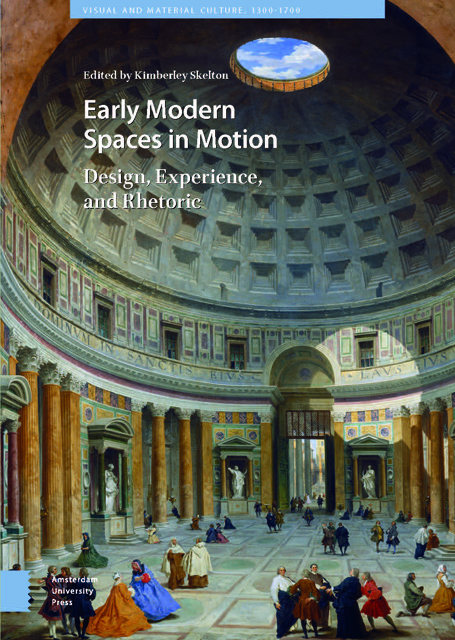Book contents
- Frontmatter
- Table of Contents
- List of Illustrations
- Acknowledgements
- Introduction: Bodies and Buildings in Motion
- 1 Navigating the Palace Underworld : Recreational Space, Pleasure, and Release at the Castello del Buonconsiglio, Trent
- 2 Passages to Fantasy : The Performance of Motion in Celliniâs Fontainebleau Portal and the Galerie François I
- 3 The Catholic Country House in Early Modern England : Motion, Pietyand Hospitality, c. 1580â1640
- 4 Sensory Vibrations and Social Reform at San Michele a Ripa in Rome
- 5 The Rise of the Staircase: Motion in Eighteenth-Century Dutch Domestic Architecture
- 6 Movement through Ruins: Re-experiencing Ancient Baalbek with Jean de la Roque
- 7 A Paper Tour of the Metropolis : The Architecture of Early Modern London in the Royal Magazine
- 8 Libraries in Motion: Forms of Movement in the Early Modern Library (1450-1770)
- Works Cited
- Index
6 - Movement through Ruins: Re-experiencing Ancient Baalbek with Jean de la Roque
Published online by Cambridge University Press: 11 January 2023
- Frontmatter
- Table of Contents
- List of Illustrations
- Acknowledgements
- Introduction: Bodies and Buildings in Motion
- 1 Navigating the Palace Underworld : Recreational Space, Pleasure, and Release at the Castello del Buonconsiglio, Trent
- 2 Passages to Fantasy : The Performance of Motion in Celliniâs Fontainebleau Portal and the Galerie François I
- 3 The Catholic Country House in Early Modern England : Motion, Pietyand Hospitality, c. 1580â1640
- 4 Sensory Vibrations and Social Reform at San Michele a Ripa in Rome
- 5 The Rise of the Staircase: Motion in Eighteenth-Century Dutch Domestic Architecture
- 6 Movement through Ruins: Re-experiencing Ancient Baalbek with Jean de la Roque
- 7 A Paper Tour of the Metropolis : The Architecture of Early Modern London in the Royal Magazine
- 8 Libraries in Motion: Forms of Movement in the Early Modern Library (1450-1770)
- Works Cited
- Index
Summary
Abstract
This paper considers the account of the ruins of Baalbek in Jean de la Roque’s Voyages de Syrie et du Mont-Liban. Published in 1722, thirty-three years after his visit to Lebanon, it represents the first detailed account of the ruins. The re-attribution of a manuscript letter in Aix-en-Provence confirms that La Roque never visited the site; instead, he seems to have based his account on the drawings of Andre de Monceaux executed around 1670. Yet, although not based on genuine autopsy, his detailed description presents the architecture from the perspective of a viewer moving among the ruins. This prominent imagination of the motion of the spectator, derived from Lucian’s architectural narratives, constitutes a revolution in the genre of architectural description.
Keywords: Jean de la Roque, Baalbek, Lucian, Andre de Monceaux, travel narratives, ruins, ekphrasis
In the eighteenth century, the Voyages de Syrie et du Mont-Liban of Jean de la Roque (1661-1745) was a recognized authority on the history and culture of the Levant. It recounted a journey there between 1688 and 1690, but was published over thirty years later, in 1722. Dedicated to Andre-Hercule de Fleury (1653-1743), future cardinal and tutor to Louis XV, it belonged to a genre of travel narratives, or récits de voyage, which had become popular since the later seventeenth century; their marked ethnographical emphasis involved a conscious reflection on French home culture. For the present volume, the significance of La Roque’s work is the impact of his account of the buildings of Baalbek on the genre of architectural description whose earlier narratives had been dry and inert. The main precursor in France, the antiquarian Jean Poldo d’Albenas’s Discours historial (1560) on the ancient remains of Nimes, was enlivened by virtuoso architectural plates inspired by Italian drawings after the antique, which created a new ‘archaeological vision’ of the built environment, but its written descriptions present a static image of architecture and little direct encounter with the experience of place. By contrast, La Roque’s description of Baalbek is supported by only two visual illustrations, which lack the precision of Poldo’s plates; but his written narrative shows greater attention to the experience of architecture and leads the reader through the remains, introducing a sense of motion to the genre.
- Type
- Chapter
- Information
- Early Modern Spaces in MotionDesign, Experience and Rhetoric, pp. 163 - 188Publisher: Amsterdam University PressPrint publication year: 2020



